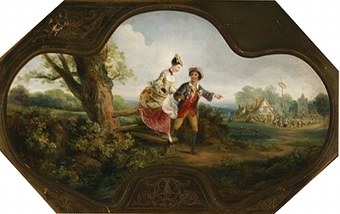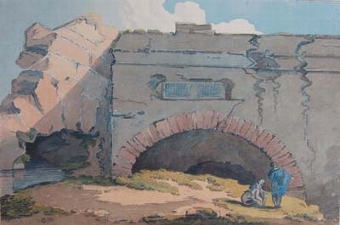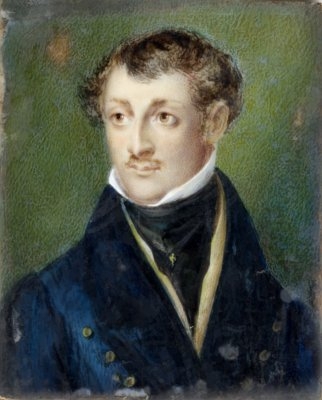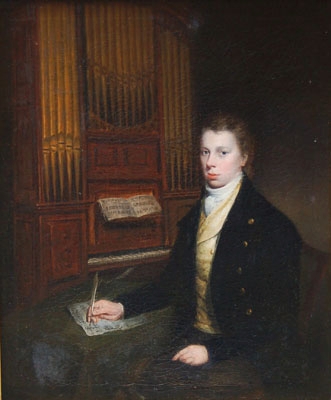portrait of niccol? mauruzzi, best known as niccol? da tolentino 1350-1495
- View other items in:
- antiques interior design modern and vintage
- other interior design
artware ltd
Enquire about this antique
Artware Ltd has 565 antiques for sale.
click here to see them all
Niccol? Mauruzzi (or Mauruzi), best known as Niccol? da Tolentino (c. 1350 ? March 20, 1435) was an Italian condottiero. He should not be confused with Saint Nicholas of Tolentino. A member of the Mauruzi della Stacciola family of Tolentino, he fled from that city in 1370 after a disputes with his relatives. He therefore fought under several condottieri. In 1406-1407 he commanded the troops of Gabrino Fondulo, lord of Cremona, and subsequently was under Pandolfo III Malatesta, lord of Fano and Cesena. After having obtained from Malatesta the title of count and the castle of Stacciola near the Metauro river, he was hired by numerous Italian lords, including Filippo Maria Visconti, Queen Joan II of Naples and the Republic of Florence (1425). In 1431 he was made seignior of Borgo San Sepolcro by Papal decree, but the following year he lost it as he passed under the Florentines, whose armies he led from June 1423 to May 1434, with intervals as Papal commander-in-chief in 1424 and 1428-1432, and commander of Milanese troops in 1432.
For Florence he seized Brescia and won the Battle of Maclodio (October 12, 1427). After these successes he was appointed capitano generale (commander-in-chief) of the Republic in 1431 and in 1432 he was sent as commander of coalition against Francesco I Sforza in Romagna, where he was victorious at the Battle of San Romano (famous for a painting by Paolo Uccello). A portrait of Niccol? was executed in Santa Maria Novella as memory of his deeds. In 1434 he was captured by the Visconti and thrown into a ravine. He survived, but died of the wounds the following year at Borgo Val di Taro. He was buried in Santa Maria del Fiore in Florence, a celebrating fresco by Andrea del Castagno commissioned over his tombs by the Florentine commune. His son Cristoforo da Tolentino was also a condottiero.
Not long after the SS. Annunziata comission, the Opera del Duomo commissioned the monument to the commander Niccol? da Tolentino, which Andrea completed in March 1456. For this painting Castagno had to revert to the monumental and heroic model he had used in the Legnaia cycle. His description of the tense muscles of the horse and the general''s furrowed face are very acute naturalistic observations that break the rigidity of that model. A comparison of Andrea''s Tolentino with Paolo Uccello''s Sir John Hawkwood, painted in the same cathedral several years earlier (1436), is inevitable. While Uccello froze the horse and its rider into a static composition of rigid geometric precision, Andrea expressed through the tension and movement of this fresco all the restlessness and vitality of his spirit. The Monument to Niccol? da Tolentino in Florence Cathedral is the last work by Castagno that still survives; in 1457 he frescoed a Last Supper for the convent of Santa Maria degli Angeli, but it has not come down to us.
Condottieri (singular condottiero and condottiere) were the mercenary soldier leaders of the professional, military Free companies contracted by the Italian city-states and the Papacy, from the late Middle Ages until the mid-16th century. In contemporary Italian, condottiero means "contractor", and is synonymous with the modern English title Mercenary Captain, which, historiographically, does not connote the hired soldier?s nationality. These Italian words were standard usage in English writing of the Napoleonic times that remained current in the histories until the late 20th century; because formally-employed, standing, professional armies were uncommon until late in the Napoleonic Wars (1800?1815) thus, the word Condottiere in the English language has come to denote any hired soldier.
In the thirteenth and fourteenth centuries, the Italian city-states of Venice, Florence, and Genoa were very rich from their trade with the Levantine Orient, yet, possessed woefully-small national armies. In the event, foreign powers and envious neighbours attacked, and the ruling nobles hired foreign mercenaries to fight for them; the military-service terms and conditions were stipulated in a condotta (contract), between the City-State and the Soldier (officer and enlisted man), thus, the contracted leader, the Mercenary Captain commanding, was titled the Condottiere.
From the eleventh to the thirteenth century, for European soldiers, led by professional officers, the Crusades (1095?1291) fought against the Muslims provided large-scale warfare combat experience in the foreign, Holy Land of the Asian Middle East. On the Crusades? conclusion, the first masnada (bands of roving soldiers) appeared; they were not Italian, but (mostly) German, from the Duchy of Brabant (hence, the Brabanzoni), and from Catalonia and Aragon, these last were Spanish soldiers who had followed King Peter III of Aragon to the Holy Land in October of 1282, and, post-war, remained there, seeking military employment. In Italy, in 1333, other mercenaries arrived with John of Bohemia to fight, as the Compagnia della Colomba (Dove Company), Perugia?s war against Arezzo; given the profession, some masnade were less mercenaries than bandits and desperate men. The first organised mercenaries were the Ventura Companies of Duke Werner of Urslingen and Count Konrad von Landau; Werner?s company differed from other mercenary companies because its code of military justice imposed discipline and an equal division of the contract?s income. This Ventura Company increased in number until becoming the fearsome ?Great Company? of some 3,000 barbute (each barbuta comprised a knight and a sergeant). To this, the Italian nobleman Lodrisio Visconti countered with the ?Company of St. George? ? featuring the cavalryman as the key fighting man, and not the infantryman. In Italy, the first mercenary army was led by Alberico da Barbiano, the Count of Conio, who later taught military science to condottieri such as Braccio da Montone and Giacomuzzo Attendolo Sforza. A 17th-century Condottiere, by Artemisia Gentileschi.Once aware of their military-power monopoly in Italy, the condottieri bands became notorious for their capriciousness, and soon dictated terms to their ostensible employers. In turn, many condottieri, such as Braccio da Montone and Muzio Sforza, became powerful politicians. As most were educated men acquainted with Roman military-science manuals (e.g. Vegetius?s Epitoma rei militarii), they began viewing warfare from the perspective of military science, rather than that of guts (physical courage) ? a great, consequential departure from Chivalry, the traditional medi?val model of soldiering. Consequently, the condottieri fought by out-man?uvring the opponent and fighting his ability to wage war, rather than risk uncertain fortune ? defeat, capture, death ? in battlefield combat.
The medi?val condottieri developed the art of war (strategy and tactics) into military science more than any of their historical military predecessors ? fighting indirectly, not directly ? thus, only reluctantly endangering themselves and their enlisted men, avoiding battle when possible. As a political scientist, Niccol? Machiavelli mis-interpreted that condottieri fought each other in grandiose, but often pointless and near-bloodless battles. Militarily, the condottieri line of battle still deployed the grand armoured knight and medi?val weapons and tactics after most European powers had begun employing professional standing armies of pikemen and musketeers. Funerary Monument to Sir John Hawkwood (1436) in the Florence Cathedral, by Paolo Uccello. The fresco is an important artistic commemoration of a mercenary, and a seminal development of perspective.In 1347, Cola di Rienzo had Werner of Urslingen executed in Rome, and Konrad von Landau assumed command of the Great Company. In 1362, Count von Landau was betrayed by his Hungarian soldiers, and defeated in combat, by the White Company?s more advanced tactics under commanders Albert Sterz and John Hawkwood. Stategically, the barbuta was replaced with the three-soldier, mounted lancia (a capo-lancia, a groom, and a boy); five lance composed a posta, five poste composed a bandiera (flag). By that time, the campaigning condottieri companies were as much Italian as foreign: the Astorre I Manfredi?s Compagnia della Stella (Star Company); a new Company of St. George under Ambrogio Visconti; Niccol? da Montefeltro?s Compagnia del Cappelletto (Little Hat Company); and the Compagnia della Rosa, commanded by Giovanni da Buscareto and Bartolomeo Gonzaga.
From the fifteenth century hence, most condottieri were landless Italian nobles who had chosen the profession of arms as livelihood; the most famous of such mercenary captains was the son of Caterina Sforza, Giovanni dalle Bande Nere, from Forl?, known as The Last Condottiere; his son was Cosimo I de? Medici, Grand Duke of Tuscany; besides noblemen, princes also fought as condottieri, given the sizable income to their estates, notably Sigismondo Malatesta, Lord of Rimini, and Federico da Montefeltro, Duke of Urbino; despite war-time inflation, soldier?s pay was high:
6,600 monthly florins in 1448: William VIII of Montferrat, from Francesco Sforza (Milan); the enlisted soldier?s pay was 3,300 florins, half that of an officer?s
33,000 yearly scudi for 250 men in 1505: Francesco II Gonzaga (Florence)
100,000 yearly scudi for 200 men in 1505: Francesco Maria della Rovere (Florence)
The condottieri company commanders selected the soldiers to enlist; the condotta was a consolidated contract, and, when the ferma (service period) elapsed, the company entered an aspetto (wait) period, wherein, the contracting city-state considered its renewal. If the condotta expired definitively, the condottiere could not declare war against the contracting city-state for two years. This military?business custom was respected because professional reputation (business credibility) was everything to the condottieri; a deceived employer was a reputation ruined; likewise for maritime mercenaries, whose contratto d?assento (contract of assent) stipulated naval military-service terms and conditions; sea captains and sailors so-contracted were called assentisti. Their principal employers were Genoa and the Papal States, beginning in the fourteenth century, yet, Venice considered it humiliating to so employ military sailors, and did not used naval mercenaries, even during the greatest danger in the City?s history.
In fifteenth-century Italy, the condottieri were masterful lords of war; during the wars in Lombardy, Machiavelli observed: ?None of the principal states were armed with their own proper forces?: Thus the arms of Italy were either in the hands of the lesser princes, or of men who possessed no state; for the minor princes did not adopt the practice of arms from any desire of glory, but for the acquisition of either property or safety. The others (those who possessed no state) being bred to arms from their infancy, were acquainted with no other art, and pursued war for emolument, or to confer honor upon themselves. The fifteenth-century Italian armies defeated most of the Turkish, Swiss, Hungarian, German, French, and Austrian, incursions. In 1487, at Calliano, the Venetians successfully met and acquitted themselves against the German landsknechte and the Swiss infantry, who then were the best soldiers in Europe. In time, the financial and political interests of the condottieri proved serious drawbacks to decisive, bloody warfare: the mercenary captains often were treacherous, tending to avoid combat, and "resolve" fights with a bribe ? either for the opponent or for themselves. In the event, the condotta was so profitable that the commanding condottieri officers had little interest in risking their armies; yet, if battle was due, they fought swiftly, decisively, and definitively, to leave the battlefield victorious and with as many soldiers as possible.
The ?Age of the Condottieri? began in 1494, with the first, great foreign invasion in a century: Charles VIII?s national French army, which matched the divided Italian city-states and their smaller condottieri armies. The most renowned condottieri fought for foreign powers: Gian Giacomo Trivulzio abandoned Milan for France, while Andrea Doria was Admiral of the Holy Roman Emperor Charles V. In the end, failure was political, rather than military, stemming from disunity and political indecision, and, by 1550, the military service condotta had disappeared, while the term condottiere remained current, denominating the great Italian generals (mainly) fighting for foreign states; men such as Marcantonio II Colonna and Raimondo Montecuccoli were prominent into the sixteenth and the seventeenth centuries. To wit, the political practice of hiring foreign mercenaries did not end, even in contemporary Italy, the Vatican?s Swiss Guards are the modern remnants of an historically effective mercenary army.
Antiques.co.uk Ref: KXXDNH3Y
- Materials:
- Oil on Canvas
- Width (cm):
- 127.00 x 101.60 cm 50.00 x 40.00ins
Artware Ltd
Artware Fine Art specialises in fine antique, decorative and historical portraits and topographical pictures . We cover a period from the 17th and 18th centuries through to the 19th & 20th Centuries. We have over 150 portraits in stock, which can be viewed on our web site, each historical portrait has well researched biographical information both on the sitter and the artist.
Contact details
18 La gare
51 Surrey row
London
Greater London
SE1 0BZ
UNITED KINGDOM
T: 0207 921 97904
E: greg@artwarefineart.com
W: www.artwarefineart.com














